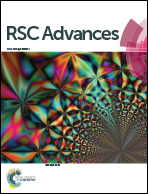Microwave-assisted synthesis of Cu2O microcrystals with systematic shape evolution from octahedral to cubic and their comparative photocatalytic activities†
Abstract
Cuprous oxide (Cu2O) microcrystals with systematic shape evolution were successfully synthesized via a facile microwave-assisted heating technique. The monodispersed Cu2O was synthesized using copper acetate as a starting material, ethylene diamine tetraacetic acid (EDTA) as a reducing agent and surface-regulating agent and a mixture of water and n-butyl alcohol as reaction solvent. Various morphologies of Cu2O microcrystals, including octahedral, truncated octahedral, cuboctahedral, truncated cubic and cubic microcrystals, were obtained by altering the volume ratio of n-butyl alcohol to water. The morphologies and optical properties of the synthesized Cu2O microcrystals were characterized by XRD, SEM, TEM, HRTEM, SADE and UV-Vis/DRS. The growth mechanism of these crystals was thereby proposed. The volume ratio of n-butyl alcohol to water in the reaction medium was a critical factor in precisely controlling the morphologies of the microcrystals. Furthermore, their comparative photocatalytic activities for the degradation of methyl orange were tested.


 Please wait while we load your content...
Please wait while we load your content...